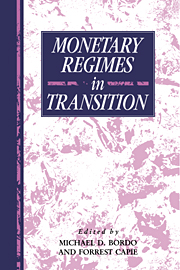Central Banks at a Crossroads
What Can We Learn from History?
$67.99 ( ) USD
Part of Studies in Macroeconomic History
- Editors:
- Michael D. Bordo, Rutgers University, New Jersey
- Øyvind Eitrheim, Norges Bank
- Marc Flandreau, Graduate Institute of International and Development Studies, Geneva
- Jan F. Qvigstad, Norges Bank
- Date Published: May 2016
- availability: This ISBN is for an eBook version which is distributed on our behalf by a third party.
- format: Adobe eBook Reader
- isbn: 9781316655726
Find out more about Cambridge eBooks
$
67.99 USD
( )
Adobe eBook Reader
Other available formats:
Hardback, Paperback
Looking for an examination copy?
This title is not currently available for examination. However, if you are interested in the title for your course we can consider offering an examination copy. To register your interest please contact [email protected] providing details of the course you are teaching.
-
Throughout their long history, the primary concern of central banks has oscillated between price stability in normal times and financial stability in extraordinary times. In the wake of the recent global financial crisis, central banks have been given additional responsibilities to ensure financial stability, which has sparked intense debate over the nature of their role. Bankers and policy makers face an enormous challenge finding the right balance of power between the central bank and the state. This volume is the result of an international conference held at Norges Bank (the central bank of Norway). International experts and policy makers present research and historical analysis on the evolution of the central bank. They specifically focus on four key aspects: its role as an institution, the part it plays within the international monetary system, how to delineate and limit its functions, and how to apply the lessons of the past two centuries.
Read more- A broad overview of the evolution of central banks and central banking with an emphasis on the lessons waiting to be learnt
- Identifies recent trends in the development of central banks and central banking in the aftermath of the recent financial crisis
- Provides valuable historical background to the current debate about the role of the central bank
Reviews & endorsements
"Economic policy makers - just as generals - tend to fight the last battle rather than the one at hand. Instead they should learn from history and try to find fundamental underlying principles that can guide policy. For those with an interest in monetary policy and the task of a central bank Central Banks at a Crossroads is a good start."
Lars Heikensten, former Governor of Sveriges Riksbank, Executive Director of The Nobel FoundationSee more reviews"How do societies remember? How are events that occur repeatedly, but that are separated by large gaps of time like financial crises, to be dealt with if every generation wants to learn their own lessons? This important volume argues that the history of central banking and central banks in practice holds out the possibility of creating two institutional attributes crucial for effective public policy: memory and patience. Casting a wider scope than monetary and banking history, the chapters suggest new ways of thinking about the role of central banks and their interaction with economies, polities, and societies."
John Joseph Wallis, University of Maryland"This book makes for fresh reading at an important juncture, as the economic recovery weakens, while some central banks begin to exit from unprecedented crisis-response policies. We live in unchartered territory, and it helps to gain a better historical perspective of central banking and the challenges these institutions face. This book should provide the basis for debate and the development of next-generation central bank policies."
Angel Gurría, Secretary-General of the Organisation for Economic Co-operation and DevelopmentCustomer reviews
Not yet reviewed
Be the first to review
Review was not posted due to profanity
×Product details
- Date Published: May 2016
- format: Adobe eBook Reader
- isbn: 9781316655726
- contains: 60 b/w illus. 30 tables
- availability: This ISBN is for an eBook version which is distributed on our behalf by a third party.
Table of Contents
Preface Michael D. Bordo, Øyvind Eitrheim, Marc Flandreau and Jan F. Qvigstad
1. Introduction Michael D. Bordo, Øyvind Eitrheim, Marc Flandreau and Jan F. Qvigstad
2. The descent of central banks (1400–1815) William Roberds and François R. Velde
3. Central bank credibility - an historical and quantitative exploration Michael D. Bordo and Pierre L. Siklos
4. The coevolution of money markets and monetary policy, 1815–2008 Clemens Jobst and Stefano Ugolini
5. Central bank independence in small open economies Forrest Capie, Geoffrey Wood and Juan Castañeda
6. Fighting the last war - economists on the lender of last resort Richard S. Grossman and Hugh Rockoff
7. A century and a half of central banks, international reserves and international currencies Barry Eichengreen and Marc Flandreau
8. Central banks and the stability of the international monetary regime Catherine Schenk and Tobias Straumann
9. The international monetary and financial system - a capital account historical perspective Claudio Borio, Harold James and Hyun Song Shin
10. Central banking - perspectives from emerging economies Menzie D. Chinn
11. The evolution of the financial stability mandate from its origins to the present day Gianni Toniolo and Eugene N. White
12. Bubbles and central banks - historical perspectives Markus K. Brunnermeier and Isabel Schnabel
13. Central banks and payment systems - the evolving trade-off between cost and risk Charles Kahn, Stephen Quinn and Will Roberds
14. Central bank evolution - lessons learnt from the sub-prime crisis C. A. E. Goodhart
15. The evolution of central banks - a practitioner's perspective Andrew G. Haldane and Jan F. Qvigstad
Index.
Sorry, this resource is locked
Please register or sign in to request access. If you are having problems accessing these resources please email [email protected]
Register Sign in» Proceed
You are now leaving the Cambridge University Press website. Your eBook purchase and download will be completed by our partner www.ebooks.com. Please see the permission section of the www.ebooks.com catalogue page for details of the print & copy limits on our eBooks.
Continue ×Are you sure you want to delete your account?
This cannot be undone.
Thank you for your feedback which will help us improve our service.
If you requested a response, we will make sure to get back to you shortly.
×







